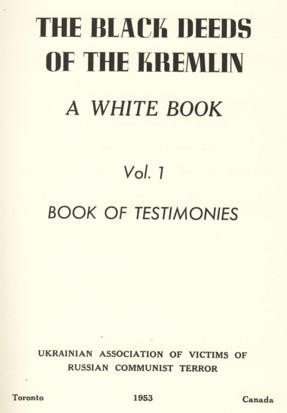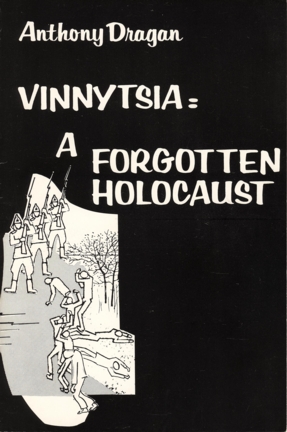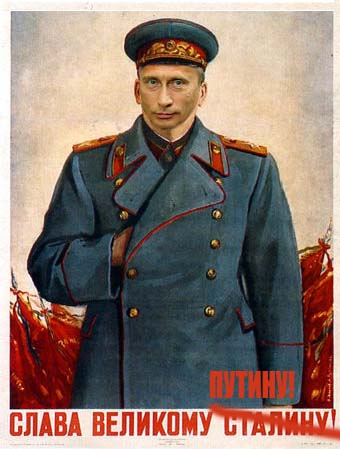
 |
Four accounts relating to the Vinnytsia Massacre appear below:
The Encyclopedia of Ukraine entry under Vinnytsia Massacre is as follows:
Vinnytsia massacre. A series of executions of thousands of citizens of the city of Vinnytsia and its surround area, perpetrated in 1937-8 by the NKVD during the Yezhov terror. The massacre was not the only action of its kind; many were carried out by the Soviet state security in prisons throughout the Ukrainian SSR. But the Vinnytsia massacre gained particular notoriety because of the extent to which it was made public. In an attempt to discredit the previous Soviet regime by highlighting the atrocities it had perpetrated, the German occupational forces, following the lead of various witnesses, exhumed the bodies of the massacre's victims between May and July 1943. To supplement the examinations made by German and Ukrainian doctors, the German authorities invited an international commission of medical experts to investigate the corpses found in 66 mass graves in the Vinnytsia area. Forensic scientists from Belgium, Bulgaria, Croatia, Finland, France, Hungary, Italy, Holland, Rumania, Sweden, and Slovakia participated in July 1943. It was reported that a total of 9,439 bodies (including 169 women) were recovered. Most of the victims had been shot in the back of the head; some had been buried alive. Only 10 percent of them were identified, largely on the strength of documents found on their persons, items of clothing, body markings, or other documents interred by the NKVD at another site. Among those identified were persons whose families had been told they had been sent to prison camps without right of correspondence. According to the testimony of Vinnytsia's citizens there were other graves, but the Germans were unable to investigate because they were eventually forced to retreat. The fact that the German Gestapo itself used the NKVD prisons and installations for mass murder prevented a comprehensive investigation of the NKVD's actions in other cities, towns and villages, both in the 1937-8 period and during the Soviet retreat of 1941. Danylo Husar Struk (ed.), Encyclopedia of Ukraine, Volume V, University of Toronto Press, Toronto Buffalo London, 1993, pp. 609-610. Two photographs that are not reproduce above had the captions "A mass grave of victims of the Vinnytsia Massacre" and "Foreign physicians performing an autopsy of the remains of a victim of the Vinnytsia Massacre." |
In the Soviet Union as a whole, the high point of the Stalinist purges came in 1937-38, but as Lev Kopelev noted, "In Ukraine 1937 began in 1933." It was probably the threat of national communism on the one hand, and the demoralization of the Ukrainian Communists by the horrors of collectivization and the famine on the other, that singled out the Ukrainians for special attention. The coming storm was heralded by an ideological shift in Moscow. For years the party had officially reiterated that Russian chauvinism was the primary threat to the Soviet system, while the nationalism of the non-Russians was less dangerous because it was essentially a reaction to the former. However, in 1933 Stalin's spokesmen, arguing that Ukrainian nationalism had greatly increased as a result of kulak support, labeled it as Ukraine's most serious problem. Thus, the way was cleared for the persecution of those Ukrainian Communists who had been closely linked with Ukrainization.
sands of local officials in the countryside with his own men. Simultaneously, he launched an attack on the Ukrainizers. Denouncing the emphasis on "national specificity" as a "refusal to submit to all-union interests," he described Ukrainization as a "cultural counter-revolution" whose aim was to fan "national enmity among the proletariat" and "to isolate the Ukrainian workers from the positive influence of Russian culture."
sion, purges, subjugation and all types of bureaucratic hooliganism in general assume such deadly proportions as in Ukraine in the struggle against powerful subterranean strivings among the Ukrainian masses towards greater freedom and independence."
abroad or had relatives abroad, and immigrants from Galicia; even average citizens perished in huge numbers. An indication of the vast scope of the Great Purge was the discovery during the Second World War, in Vinnytsia, of a mass grave containing 10,000 bodies of residents of the region who were shot between 1937 and 1938. Given the lack of complete data, it is difficult for Western scholars to establish the total loss of life brought about by the Stalinist terror. Adam Ulam and others estimate that in the Soviet Union as a whole, about 500,000 were executed in 1937-39 and somewhere between 3 and 12 million were sent to labor camps. One can assume in light of the above-mentioned factors that Ukraine's share of those who were victimized was disproportionately high.
Orest Subtelny, Ukraine: A History (2nd ed.), University of Toronto Press, Toronto Buffalo London, 1994, pp. 418-421. Footnotes deleted. From "Abbreviations" on p. 621 comes the information that CPU is Communist Party of Ukraine; CP(b)U is Communist Party (bolshevik) of Ukraine; NKVD is People's Commissariat of Internal Affairs (Soviet political police); OGPU is Unified State Political Administration (Soviet political police). From "Glossary" on p. 613 comes the information that kulak means "well-to-do peasant." |
 The Black Deeds of the Kremlin PDF (19.9 mb) |
The Vynnytsya murders are a reminder to the free world of the risk it runs by continuing to deal with these insane and fanatical Kremlin murderers in the same way as it does with other civilized and humane governments or political parties. � Prof. I. Roz'hin, D.Sc. (p. 416)
The policy-makers of the world must realize that events in this atomic age are leading in a frantic tempo to a clash between two worlds: a world of truth and a world of lies, a world of light and a world of darkness, slavery and savage terror. The Kremlin knows that one of these worlds must fall, and in a planned, furtive way is preparing to dominate the world. � Stepan Fedoriwsky (p. 420)
How can one comprehend the tragedy of a simple school-teacher who fell into the NKVD claws and into the mass grave, together with his notebooks? This indicates that there had not been time to indict and try the arrested. They were given a bullet in the nape of the neck immediately upon being seized. Some of them had clay in their mouths, showing that they were still breathing when buried. � Bishop Sylvester (p. 421)
When the communists returned to Vynnytsya in 1944, Rapoport, the last NKVD chief, announced that all those who had remained during the German occupation were required to appear. From these they picked out the ones who had identified their relatives dug up from the mass graves. Thus, they collected two hundred people, shot them and threw them into the open pits. � Kost Sybirsky (p. 429)
The large grave in "Kozytsky Park" was not re-opened. It covered the Cheka and GPU victims of 1923. � P. Pavlovich (p. 432)
4. Details � Vinnytsia: A Forgotten Holocaust
 Vinnytsia: A Forgotten Holocaust PDF (3.7 mb) |
After the mass arrests, relatives tried to secure some measure of "justice", but seeking "justice" in this system was in and of itself a crime. And so they did what they could � they kept vigil at the prison walls, went to the NKVD offices, and in their naiveté, even went so far as to write to Stalin himself, asking him to help them in finding and freeing their relatives. But in ninety nine out of a hundred cases, the response was that those arrested had been sentenced as "enemies of the people" and sent to far-off camps, "without the right to correspond". Some 10 thousand of these "enemies of the people," sent off to far-away camps, "without the right to correspond," were found, with their hands bound behind their backs and their skulls crushed, in the mass graves of Vinnytsia (p. 14).
Out of the 169 female corpses that were exhumed, 49 were completely nude. According to the report of the medical commission, these were all women of young age, as were the majority of female corpses that were clad only in long shirts. This suggested, and was later borne out in testimony, that these women had been raped prior to being executed. Only the corpses of a few older women were found fully clothed. There were only a few cases where the female corpses were found with their hands bound (p. 38).
All of the exhumed corpses showed signs of having been shot, most of them in the back of the head. The cause of death could not be determined only in those few cases where the corpse was damaged in the process of being exhumed. In most of the cases, bullets were found still embedded in the skulls. Many bore signs indicating that more than one bullet had been used: 6,360 victims were shot twice; 78 victims were shot three times; and two victims were shot four times; the remainder were either shot once, or the number of shots could not be determined. Some of the skulls were either bashed in or showed signs of having received severe blows, most likely, with a pistol. Some of the corpses had been shot in the forehead or in the temple. Others, apart from having been shot in the back of the head, had their mouths gagged; still others were found with a noose around their neck (p. 39).
As for the place of execution, the reports of the commission concurred with the accounts given by witnesses that, except for a very few, the victims were not executed at the site of the burial. This was confirmed by the absence of cartridges at the sites. The fact that few cartridges were found, and that only a few corpses were found on top of piles of clothing beneath which lay hundreds of corpses, indicates that only a few victims were executed directly at the burial spot.
These were probably the corpses of the men who were to bury the victims. There is speculation that the NKVD commissars executed them in order to get rid of any witnesses, and thus minimize the chances of having the crime discovered.
The accounts given by relatives and the results of the general investigation conducted by the commission give reason to believe that the executions were carried out in the yard of the NKVD building (pp. 41-42).
The Nazi crimes have been investigated and documented by the Nuremberg Trials. Some of the countless crimes perpetrated by the Communist regime under Stalin's dictatorship were condemned by his own "advisers" and henchmen after his death.
Why is it that Vinnytsia is never mentioned? Why is it that at present, many years after these awful crimes, UNESCO sponsors anniversary celebrations for Lenin, hailing him as a "great humanist," when actually he was the source of inspiration for these bloody crimes. How is it that representatives of the system which perpetrated and is responsible for the genocide of which Vinnytsia represents only a small part are today received as partners in international negotiations, even by the Vatican? In the words of Patriarch Josyf Slipyj at the synod of bishops held in October, 1971, "Not only do these people choose to ignore the countless corpses and the rivers of blood that were shed," in sacrifice by the Ukrainian nation, but for the sake of "diplomacy," they prevent others from seeing the truth and speaking out (pp. 50-51).
Are There Other Mass Graves?
Robert Conquest opens up the possibility that mass graves are common in Russia, Belarus, and Ukraine, and that a mass grave containing 10,000 bodies is not one-fifth of the way to setting a record:
As I write, mass execution sites are known in several places: the one in Vinnitsa, discovered by the Germans in 1943, where over 9,000 corpses were exhumed, even though part of the area remained uninvestigated; one between Khabarovsk and Vladivostok, where some 50,000 seem to have been executed in 1937 and 1938; one at Gorno-Altaisk; one at Bykovnya, near Kiev; one, with over 46,000 bodies, near Leningrad; one near Tomsk; one close to the well-known Polish grave site at Katyn; near Chelyabinsk; near Poltava; in Donetsk; near Voronezh; and, above all, the mass grave at Kuropaty, near Minsk, of which much was written in the Soviet press in 1988 and 1989, which became the eponym of the later discoveries and where no fewer than 50,000 victims lie buried, while considerably higher estimates have been given in the Soviet press. These included many from newly annexed western Byelorussia in 1939 to 1941 (five of the eight mass graves actually dug up were of western Byelorussians, and three were from 1937 and 1938, though this may not be representative). The total in any case is unexpectedly large, especially when five more sites are reported waiting investigation in or near Minsk alone, with others in the Byelorussian provincial capitals. And Byelorussia had in 1937-1938 about one-thirteenth, or 3.4 percent, of the Soviet population, and even in 1939-1941 only about one-eighteenth, or 5.6 percent. The great majority of the dead were peasants and workers. Robert Conquest, The Great Terror: A Reassessment, University of Alberta Press, Edmonton, 1990, p. 288. Footnotes excluded. |

GLORY TO THE GREAT |